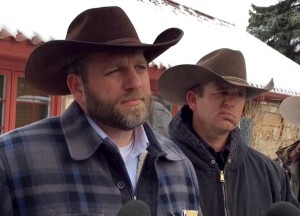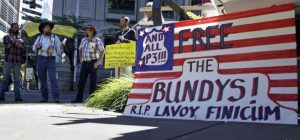 RECAP: Week One in a Nutshell
RECAP: Week One in a Nutshell
After spending a week observing the Oregon Standoff Trial, and producing short video clips summarizing what is happening, I’m not going to attempt to summarize or recap the first week of trial in a video clip. If you want to hear a partial recap of the week, prior to Friday’s testimony,
check-out my video interview summary for Newsbud. Or check out the video recap of the
Motion for Mistrial. I’m ready for a break from video production, and by writing the recap, consistent with my pattern, I can then spend the next several days tweaking it, which just doesn’t work well with video clips.
I want to make something very clear right at the outset. Although I’m involved in some sort of media role here, I’m not a reporter. I’m not even pretending to be a reporter. As part of my assignment, I am reporting some stuff to provide context, etc., but mostly I am a commentator. My main assignment is to provide commentary. I’m not even pretending to be completely objective. I have a view point. Based on my experience and view points, I am seeking to provide another perspective. Based on my background, in addition to providing general commentary, from my unique perspective, I am also going to provide some legal commentary — for what it’s worth — at the end of this piece.
Based on the first week, if I had to summarize the Government’s case at this point in just two words, those words would be: Overreaction & Overexaggeration. And it’s the government’s evidence we’re talking about here. The government is presenting its case in chief. Some of the defendants have been accused of exaggeration, but we’re still weeks away from having a chance to see their evidence and hear what they have to say. This is the government’s case — the government’s evidence.
Case in Point: Judicial Security Theater
Back when the Malheur Occupation first occurred, back in January,
I coined a new phrase “Standoff Pageantry.” In a subsequent discussion I had with radio host Peter B. Collins, he compared it to his newly-minted phrase of “Security Theater,” and now, based on what is going on at the Standoff Trial in Portland, I’m going to coin yet another phrase combining the two: “Judicial Security Pageantry.” There’s a whole lot of drama, pageantry and theatre going on at the federal courthouse in

Portland associated with the Oregon Standoff trial. Among other things, on one side, there are a handful of die-hard supporters, there with signs, protesting what is going on. On the other hand, the federal government, including DHS, is there in full force — just like the federal government was out in force in Burns, Oregon back in January and February.
Unfortunately, despite being there in court every day, covering the trial the entire week, I missed the single biggest piece of drama. While I was working on producing my little video clips summarizing the day’s events, late Thursday afternoon,
a gentlemen by the name of Mathew Thomas Mglej, apparently a Portland native, approached the federal courthouse and was taken down in grand fashion

by an army of DHS police with guns drawn. Apparently, back in 2014 Mr. Mglej had previously been arrested and charged for playing a violin outside the courthouse while naked. He was charged with indecent exposure, but the charges were later dropped. On Thursday, the government claims he had an unloaded .22 rifle wrapped in a towel. His efforts resulted in major drama and corresponding Judicial Security Theatre in downtown Portland. Unfortunately, I missed it. It is hard to say what, if anything, any of this actually had to do with the Oregon Standoff Trial, but it helps reinforce an important point.

(This isn’t an actual image of the arrest on Thursday, but is similar to what happened, and is used to help emphasize the point)
Despite all it’s huff, and puff, and bluster, the federal government literally acts like its scared of its own shadow, and is highly prone to overreaction. Here it is, the biggest, most powerful temporal entity in existence — in the history of this planet, and naked violin players can send the federal government into full scale panic.
Back on August 31, 2016, RANGEFIRE! posted the first/last part of a series of articles about
Realities in the West that nobody wants to talk about, called “Welcome to the New Normal — a Land of Labels, Distortions, Misinformation, and Guilt by Association.” I wrote that piece clear back in May, to address, at least in part, what was going on with Stanton Gleave, and the feeding frenzy of misinformation surrounding him and his family. At this point, I’m going to add another word to the whole description, that should have been included from the outset:
OVERREACTION.
In that piece, among other things, I said:
“The reality is this too was nothing more than misinformation. The completely unauthorized image was the unintentional product of a staged, media photo-op, intended solely to see what kind of reaction it would draw. It’s the sort of pomp and circumstance scenario that happens all the time in many situations. In previous pieces, such optics have been referred to as pageantry — in some cases Standoff Pageantry. The problem is few people seem to be able to distinguish between what is real and what isn’t. . . . But distortions, fueled by social media, seem to be the order of the day on all sides. For good examples of distortions on the other side of the fence, consider the multiple articles Chris Zinda has written on this subject, and his treatment of the role of social media in the whole equation.
During the first week of trial, both Chad Karges(MNWR manager) and Jeff Rose (Burns BLM field office manager) testified that from the minute Ammon Bundy and Ryan Payne arrived in Harney County, federal offices, officials, and law enforcement were on high alert. In addition to receiving a continuous flow of “intel” from law enforcement, Karges and Rose were both actively monitoring social media. Both they and Sheriff David Ward all testified that they couldn’t put their finger on any actual threats, but they all said that just the mere thought or mention of “Bunkerville,” and some of the people who had been there, in Sheriff Ward’s words “scared the Hell out of him.” Likewise, both Karges, Rose and their supervisors decided to shut down the BLM office in advance, before the occupation ever occurred, based almost entirely on the fact that a protest rally was planned to support Dwight and

Steven Hammond. At the same time, Rose testified that the occupation of the Malheur Refuge was a complete surprise. They thought if something was going to happen it would be at the BLM office in Hines, where the only thing that actually happened was the placement of signs saying “Closed Permanently.” Jason Curry, a special agent for the BLM testified, however, that the signs had been up for less than an hour on Saturday, January 9th, more than a week after all the decisions to close offices had been made, and a full week after the occupation started, but both he and Rose testified that the signs contributed to the decision to keep the office closed.
At this point, I’ll have to say that none of that testimony really surprised me much. I live in Millard County, Utah, the better part of 1000 miles away from Harney County, Oregon. There is a BLM field office in Fillmore, approximately 15 miles from where I live. I am good friends with one of the BLM managers who works there. Her husband is one of my best friends. This whole year her husband and I have just had to scratch our heads and laugh every time the BLM gets its panties in a wad, goes on high alert, and puts the field station on lock down. It has happened on multiple occasions since January 2016. Once, it happened when a “liberty convention” was scheduled to happen at the Old Statehouse in Fillmore. On another occasion, something as off-the-wall as Gavin Seim passing through the area, caused a major reaction at the office.. And just to add context to this whole discussion, Sagebrush alarmist Chris Zinda is likewise the husband of a BLM manager, Cedar City District Manager, Heather Whitman. Translation: conspiracy theories abound among federal employees and the people they listen to.
Between what I heard Chad Karges, Jeff Rose and Sheriff Ward testify at trial, coupled with the kind of stuff Chris Zinda regularly comes up with, I can’t even imagine the kind of frenzy these people are capable of working themselves into. I can’t even imagine the kind of paranoia they must live with. And the funny thing is people accuse the so-called “patriots” of being paranoid and out-of-touch-with reality? At least the so-called patriots don’t have the full resources of the United States government at their disposal to spend in chasing these fears.
Back to the point I wrote back in May, which has become abundantly clear in just the first week of the Oregon Standoff Trial, and I’m going to repeat at least three times in this article: “
The problem is few people seem to be able to distinguish between what is real and what isn’t.” Here’s the deal, for the most part, what happens on Facebook, and social media isn’t real. The vast, vast majority of it simply has no connection to reality. It’s an alternate reality that doesn’t exist in reality. People say all kinds of nonsense, and unadulterated bullshit on Facebook and social media all the time. It’s an absolute feeding frenzy of misinformation — from all sides, and in all directions. Some of us figured that out long ago.
Back to my point:
The problem is few people seem to be able to distinguish between what is real and what isn’t. And the even bigger problem is
overreaction to things that are not real, and overexaggeration in attempting to describe and justify the overreactions. Below is one of the videos that stoked government officials’ fears, and they overreacted to.
The Government’s Case
In the first week of trial, the government’s case actually started out pretty flat. The government promised shock and awe, but so far has not been able to deliver. The government said that it would present eye witness evidence that would make the refuge takeover look like a military operation in Iraq or Afghanistan. But what their witness testified did not live up to their billing. Likewise, much of their social media evidence came across as pretty benign, leaving a person scratching their head, thinking “is that the best you’ve got — so this is what this case is about?” Although some of the social media evidence may certainly be troubling, it certainly didn’t rise to the level of documenting a conspiracy to impede or interfere with federal officers doing their jobs. There is only one explanation for that response: overreaction.
All of the government decision-makers testified that they weren’t aware of any real threats. They just had feelings of fear and concern, based in large measure on their own monitoring of social media, coupled with information the FBI was feeding them to increase their concerns. So here’s number four:
Part of the problem is few people seem to be able to distinguish between what is real and what isn’t.
Although the federal government is prosecuting the case, everything about its case so far depicts the federal government on the defensive. The government is extremely defensive about issues of jurisdiction and adverse possession — doesn’t even want to go there. The government doesn’t want to have to try to explain anything. And when it comes to the alleged threats, instead of sounding like confident leaders, who might consider actually engaging in some kind of proactive discussion, these government officials acted more like they were unreasonably afraid of their own shadows, taking most of their directions from the FBI, in order to set the stage for how they wanted to portray the narrative, and were prepared to shut down government offices down for no real good reason. Between the BLM, USFWS and federal law enforcement, including the FBI, it sounds like they were involved in a feeding frenzy of fear. And people want to accuse the defendants and others of tinfoil hat theories?
In conclusion, and just to highlight this point, Chad Karges testified that the so-called “restoration” work at MNWR headquarters is already complete and has been for some time, but the headquarters remains closed, and there is no plan to re-open until sometime in 2017. If you’re not asking WHY, you should be.
Trial Performance
When a naked violin player (who wasn’t even naked at the time) can steal the show, you know there’s a problem.
In terms of legal commentary, right out of the chutes, with all due respect to the attorneys involved, I’m going to say this: Ryan Bundy is out-lawyering the lawyers — certainly the other defense lawyers.
Although, in my opinion, much of the government’s evidence is very marginal, and I continually have people asking me if some of the things they are presenting doesn’t actually support the defendants’ case better than the prosecution, but they are doing a very good, efficient job of presenting the evidence they have chosen to present — which is apparently the best they have. Their examination is crisp and seemingly very well-rehearsed, and they always seem to have objections on the tip of their tongues.
On the other side of the table, make no mistake, there were some really good opening statements. Matt Schindler, representing Ken Medenbach, and Lisa Maxfield, representing Neil Wampler, did a particularly good job. But in his opening statement Ryan Bundy did a very effective job communicating his view of the case as well. And when it comes to objections, he is probably actually doing a better job than any of the defense attorneys. This should be both troubling and highly disconcerting to those attorneys. For a lay person, with no formal legal education, law training, and minimal experience, Ryan is holding his own fairly well, which, unfortunately, doesn’t say much about defense counsel in the case, and it is time for them to think about that.
I realize it is very easy for us to sit back and attempt to play armchair quarterbacks, but I agree with Mike Arnold that the assigned federal public defense attorneys seem very capable of making good arguments, but there’s a whole lot more to trying a case than making good arguments. They are arguably lacking when it comes to basic trial skills like cross examination and making objections. Arnold suggested that is probably due to the fact that they spend most of their time on plea deals, and making arguments at sentencing, instead of actually trying cases. And it shows. Although Lisa Maxfield has had some effective cross examination, for the most part, and I’m sorry, I know this is going to step on some toes, but they seem more like potted plants sitting there.
Forgive me for that analogy. It takes me back to the summer of 1987. In early July I was traveling cross country with my wife Heidi, from Utah, to Ithaca, New York, where I was on the waiting list at Cornell Law School. The Iran-Contra Hearings were going on that summer. Although it would drive Heidi crazy, as the over-eager soon-to-be law student, I was trying to listen to all of it as we drove. Then at night, I would catch the news

coverage in our low-budget motel rooms. Plus remember, this was almost 30 years ago. Media was different then than it is now. I don’t remember Marine Col. Oliver North’s attorney’s name, but I do remember him. He just sat there during most of the examination of Col. North, but all the sudden on one occasion, he blurted out an objection, and had something to say that seemed to catch everyone completely by surprise. Based on their reactions, he said “I’m not just a potted plant sitting here.” That phrase has stuck with me ever since, and seems to have some application here.
To be completely honest, and again with all due respect, following opening statements, most of the defense attorneys have seemed more like potted plants than actively engaged defense attorneys, zealously defending their clients’ interests. Their objections have been either non-existent or deplorable. When Ryan Bundy can make better objections than they do, it’s an issue. And Judge Brown has actually called them out about it — asking why they aren’t making more and better objections. Like Arnold also mentioned, it may be as much a result of lack practice as anything. They may all be very experienced federal criminal defense attorneys. They may all be very experienced at doing plea deals. But that doesn’t mean that they are experienced, practiced and well-honed trial attorneys. And it’s really starting to show. But if they get with the program, this one trial can give them more practice than dozens of small ones. And I get it. Some of them (especially those representing Jeff Banta, David Fry, Neil Wampler, and Ken Medenbach, for example) probably feel like it is the Bundy legal team’s responsibility to do most of the work, because their own clients seemingly have much less at stake in the whole thing. They view it as the “Bundy” trial, and their clients aren’t Bundys.
Otherwise, in a crowded courtroom well-decorated with potted plants, it might as well be a grand ballroom, with Judge Brown and the prosecution engaged as dance partners in an elaborate waltz, with Judge Brown leading, and the prosecution hustling to follow her cues, occasionally encountering the defendants and their attorneys, as they attempt to gracefully negotiate the dance floor — with the jury just trying to make some kind of sense of what is going on.
And that brings us to the most important component or player in the whole equation: the Jury.
I share concerns expressed by my colleague, Mancos MacLeod, when it comes to modern juries. The jury hearing this case started out with 20 people, comprised of 12 regular jurors and eight alternates. One of the initial 12 was excused essentially right off the bat, and an alternate juror was drawn by lot to take that juror’s place. Of the jurors currently seated as the 12 who will decide the case, eight are women.
I don’t pretend to have the jury figured out at this point, but I will offer a few inside observations. One or more members of the jury seem/s to be hypersensitive, and has repeatedly complained to Judge Brown that members of the public seated in relatively close proximity are being too loud, interfering with their ability

to concentrate. Consequently, Judge Brown has repeatedly chastised or admonished members of the public to be as quiet as possible, and to be careful about not just whispering, but coughing, clicking pens and rustling papers. This all came at times when I hadn’t noticed anything particularly out of the ordinary. There are approximately 20 members of the public in the courtroom, breathing, and trying to take notes, etc. All I can say, based on the writing that is on the wall after the first week, is that this trial is going to get real long for some people.
At the close of the day on Friday, however, after the jury had been excused, Judge Brown stated that she had a lot of confidence in this jury, because, in her words, they are following her instructions very faithfully and carefully.
So that should provide some very clear insight into where this whole thing appears to be headed. Although the jury is supposed to be deciding the case, there is no question about who is in charge, and whose lead the jury may be following in lockstep.
If you want to criticize or argue with my analysis, all I ask is that you do it from a vantage point of first hand experience — go to court and see for yourself what is going on before attempting to poke holes in what I’m saying based on some attempted third or fourth-hand perspective or predisposition about what is going on.
I invite anyone who is interested to spend some time at the trial. It is an educational experience.























 Steven Hammond. At the same time, Rose testified that the occupation of the Malheur Refuge was a complete surprise. They thought if something was going to happen it would be at the BLM office in Hines, where the only thing that actually happened was the placement of signs saying “Closed Permanently.” Jason Curry, a special agent for the BLM testified, however, that the signs had been up for less than an hour on Saturday, January 9th, more than a week after all the decisions to close offices had been made, and a full week after the occupation started, but both he and Rose testified that the signs contributed to the decision to keep the office closed.
Steven Hammond. At the same time, Rose testified that the occupation of the Malheur Refuge was a complete surprise. They thought if something was going to happen it would be at the BLM office in Hines, where the only thing that actually happened was the placement of signs saying “Closed Permanently.” Jason Curry, a special agent for the BLM testified, however, that the signs had been up for less than an hour on Saturday, January 9th, more than a week after all the decisions to close offices had been made, and a full week after the occupation started, but both he and Rose testified that the signs contributed to the decision to keep the office closed.